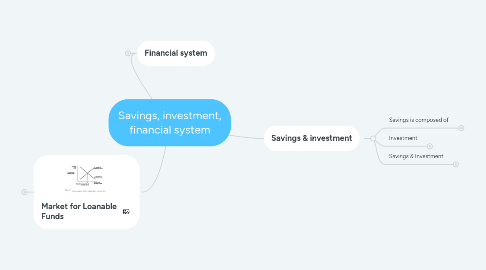
1. Financial system
1.1. 2 ways firms can finance expansion
1.1.1. Retained earnings
1.1.1.1. by reinvesting profits back into the firm
1.1.2. via Financial system
1.1.2.1. markets & financial intermediaries through which firms acquire funds from households.
1.2. Financial markets & intermediaries
1.2.1. Financial market
1.2.1.1. where financial securities are bought and sold.
1.2.1.1.1. stocks & bonds
1.2.1.2. Terms
1.2.1.2.1. Financial security
1.2.1.2.2. Stock
1.2.1.2.3. Bond
1.2.2. Financial intermediary
1.2.2.1. are firms that borrow funds from savers and lend them to borrowers.
1.2.2.1.1. banks, mutual funds, pension funds, insurance companies
1.2.2.2. Some financial intermediaries, like mutual funds, sell shares to savers then use the funds to buy financial securities.
1.3. 3 key services of the financial system
1.3.1. Risk-sharing
1.3.1.1. By allowing investors to spread their money over many different assets, investors can
1.3.1.2. reduce their risk while maintaining a high expected return on their investment
1.3.2. Liquidity
1.3.2.1. The financial system allows savers to quickly convert their investments into cash.
1.3.3. Information
1.3.3.1. The prices of financial securities represent
1.3.3.1.1. the beliefs of other investors and financial intermediaries
1.3.3.1.2. about the future revenue stream from holding those securities.
1.3.3.2. This aggregation of information makes funds flow to the right firms.
2. Market for Loanable Funds
2.1. interaction of borrowers & lenders
2.1.1. determines the market interest rate &
2.1.2. quantity of loanable funds
2.2. Households supply funds to firms
2.2.1. supply more funds when higher interest rates are offered
2.3. Firms borrow funds from households
2.3.1. borrow more when households demand a lower real interest rate
2.4. increase in demand
2.5. decrease in supply
2.5.1. How occurs:
2.5.1.1. Government runs a deficit
2.5.1.2. to fund deficit, gov't sells bonds to households
2.5.1.2.1. in other words Government borrows money
2.5.1.3. now households have less $ to loan which shifts curve left.
2.5.1.4. Effect:
2.5.1.4.1. raises real interest rate
2.5.1.4.2. decreases the amount of funds available to loan to firms
2.5.1.4.3. Crowding out
2.6. Summary
2.6.1. Summary
2.6.2. Summary
3. Savings & investment
3.1. Savings is composed of
3.1.1. private savings
3.1.1.1. all household income that is not spent
3.1.1.2. Sprivate = Y + TR - C - T
3.1.2. public savings
3.1.2.1. government income that is not spent
3.1.2.2. Spublic = T - G - TR
3.1.2.3. When Spublic = 0
3.1.2.3.1. balanced budget
3.1.2.4. When Spublic > 0
3.1.2.4.1. surplus
3.1.2.5. When Spublic < 0
3.1.2.5.1. deficit
3.1.3. Total savings
3.1.3.1. Stotal = Sprivate + Spublic
3.1.3.2. Stotal = Y - C - G
3.2. Investment
3.2.1. I = Y - C - G
3.3. Savings & Investment
3.3.1. S = I
